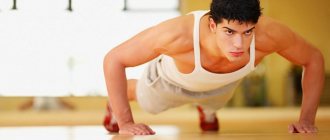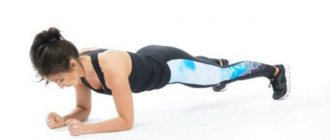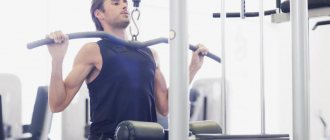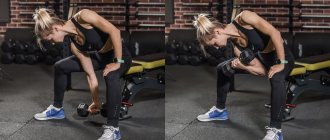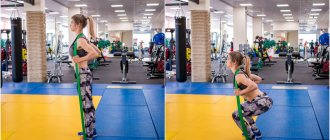Isometric exercises are the so-called “static” training. Its essence is to counteract the resistance of a particular object for a certain period of time. This method is also effective for increasing strength and endurance. Isometric exercises are great for strengthening muscles. A good example is the plank exercise. Static training of this type is often included in strength training and yoga programs, as well as in military training. The peculiarity of isometric exercises is that you simply tense the muscles without changing their length, while the joints do not move.
“Some people with thin legs are stronger than people with thick legs. Why? Because the power lies in the tendons, in those invisible hard tissues that are second in density only to bones. Without tendons, a person would turn into jelly. But the tendons need to be trained. From my experience, one can be convinced that a large man does not necessarily have to be strong, but a man of modest build does not have to be weak.”
- these are the words of one of the founders of isometric exercises, Alexander Zass (“Amazing Samson”, “Iron Samson”). Since childhood, this man was not distinguished by outstanding physical characteristics, but he believed that the strength of athletes lies not in muscles, but in tendons. Based on this belief, he developed a program to strengthen them and achieved unprecedented results. With a weight of 63 kilograms, he broke chains that could withstand a load of 800 kg, and easily lifted the horse. Currently, scientists associate this phenomenon with biochemical processes in the body in conjunction with fortitude.
Isometric simulators, exercises and training rules
What are isometric trainers
Rules for performing exercises on isometric trainers
The isometric exercise machine is designed to locally develop the strength of individual muscle groups. Isometric trainers provide programmed workouts in an isometric manner. It is important to know that the manifestations of strength are limited not so much by the muscles as by the strength of the ligaments and tendons. And it is isometric exercises, when used correctly, that are most effective not only for developing muscle strength, but also for strengthening ligaments and tendons.
Recommendations for women and men
There are no particular differences between men and women in performing isometrics, therefore all recommendations are universal.
Basic recommendations:
- It is advisable to do a set of isometric movements separately from strength training, optimally alternating types of load from day to day.
- Before training, be sure to do a thorough warm-up of the whole body.
- In isometric loading, progress is tracked by the time the muscles are under load or the total number of approaches.
- Try to distribute the exercises so that they give an even load on all muscle areas.
- Pay special attention to technique; when holding a position, it plays a key role in determining the effectiveness of the exercise.
What are isometric trainers
Modern strength training techniques claim that partial repetitions are highly effective for increasing muscle strength and strengthening the ligamentous-tendon system, and each strength exercise should be performed at the short end of the range of motion, since this is where the muscles can develop maximum force.
A typical isometric leg strength trainer consists of a frame, a moving support base mounted on it with a power unit attached to it. The bench, covered with soft matting, is attached to the frame.
Isometric exercise machines have a means for fixing a certain position of the athlete, which is installed on a support base. The power unit is made in the form of two paired dynamometers, with slip rings fixed on the rods. Each of the rings is connected to a corresponding diode signal lamp of the information monitor, as well as electric stopwatches.
Pros and cons of exercise
Today, the popularity of isometric gymnastics is growing. This fact is due not only to its high performance, but also:
- short duration of each lesson;
- lack of special equipment (simulators, equipment);
- a variety of movements that are used depending on the purpose of the training;
- accessibility for everyone, including unprepared people;
- low risk of injury;
- slight sweating compared to active training;
- minimal energy consumption, which does not cause fatigue;
- developing flexibility and achieving relaxation of the body;
- getting rid of pain and stagnant processes;
- improving blood circulation and metabolism;
- development of willpower.
Interesting! Work, travel in public transport, home environment or your favorite sofa are also places where you can train.
There are practically no negative aspects to statistical gymnastics. Exercises cannot cause harm to the body and are not dangerous if you follow the technique.
Rules for performing exercises on isometric machines
The exercise is performed according to a specific program. After determining the maximum strength, the load is calculated and dosed - 70 - 90% of the maximum strength, and the time for performing the exercises is set. The athlete monitors compliance with the specified effort using a monitor. When the specified force is reached, a green light signal is displayed on the monitor, after which the electric stopwatch begins counting. After the set time has ended, the red lights light up, indicating that the exercise should be stopped.
Isometric exercises
Exercises on isometric machines can be dangerous for people with intervertebral hernia of the lumbar or thoracic spine, so they must be performed under the strict supervision of specialists. It is necessary to strictly control the load, and also, as his body receives the necessary physical preparation, to use variations of the exercise of varying intensity.
Isometric machines allow you to perform exercises such as deadlifts, squats, seated chest presses, lying and overhead chest presses, standing curls, and many others.
What rules should you follow when doing isometric gymnastics?
In order for exercises to bring maximum benefit and not harm a person’s physical condition, it is necessary to study and strictly adhere to several rules. They will help you feel the positive effect from the first days:
- It is necessary to understand that you need to increase strength gradually, starting from a minimum.
- If pain occurs while performing a particular exercise, it is better to take a break and then try again. If the situation repeats, it is worth identifying the source of the problem and eliminating it. You can return to this exercise only after a few days.
- It is very important to get the right mindset for gymnastics. You need to perceive your body as individual muscles, and not as one whole.
- If you run out of strength, you should not continue, this means that it is better to return to exercises the next day.
- When doing gymnastics at the same time with other physical activities, you should remember that breathing should be even. If shortness of breath occurs, you need to wait until it passes.
- To begin with, the most standard and natural positions are used; more complex techniques can only be progressed over time.
- During training, do not forget about rest at those moments when the muscles require it.
- Each pose is performed while inhaling.
- For the first 40-60 days, it is not recommended to perform more than 10-12 exercises. Then they can be replaced with more complex ones or the number increased.
- The best time for gymnastics is the morning, and the room should be well ventilated or go outside if possible.
- It is recommended to choose a complex in such a way that you use as many muscle groups as possible in 1 workout.
- In each pose you need to strain your muscles as hard as possible, but if there is any threat of injury, it is better to make moderate efforts.
- You need to stay in each pose for no more than 6 seconds.
- To achieve a positive result, you should practice every day.
- After isometric exercise therapy for the lumbar spine or other parts of the body, you should take a warm shower and then rub the muscles well.
The essence of the training
Muscles contract in three ways, depending on what movements are performed. Muscle contraction occurs:
- eccentric;
- concentric;
- isometric.
In the latter case, for several seconds the person resists the resistance with maximum effort. All exercises can be divided into three types:
- isometric-static movements;
- weight training;
- exercises with maximum weights.
Differences between isometric exercises and dynamic and isotonic exercises
Sports science distinguishes isometric, dynamic and isotonic exercises. We've already dealt with isometrics. Now let's find out how it differs from other types of movement.
Dynamic are movements performed with compression and stretching of the muscle, as well as movement in the working joints. These are well-known, generally accepted exercises, for example, biceps curls, bench press and others.
Isotonic are movements performed in a static-dynamic mode. This is a kind of hybrid of dynamics and statics. Isotonic exercises involve movement (stretching and contracting muscles). This is an element of dynamics.
But the movement is performed in a small amplitude (5-6 cm) and slowly: one repetition lasts 6 seconds, with constant tension in the muscles. And this already looks like static, although not its most classic version.
Advantages
In a short period of time, muscle strength increases. Static movements in isometric mode make it possible to focus attention on certain stages of movement, improve control over body position, and develop flexibility.
The use of isometric load is recommended in any workout. Regular repetitions contribute to weight loss, this is an opportunity to tighten your figure, since the deep muscle layers are included in the work, activating metabolic processes and cleansing the body of toxins. Isometrics have a positive effect on the heart and blood circulation, helping maintain hormonal balance. The load will bring many benefits during the rehabilitation period for bedridden patients. Athletes thus relieve muscle tension and pain.
Contraindications
There are no absolute contraindications for isometric exercises. The minimum and maximum programs provided by the creator of the system allow you to exercise in almost any health condition.
You should reduce the load on the body or stop exercising in the following cases:
- viral, colds, as well as inflammatory processes accompanied by severe fever and headache;
- high or low blood pressure;
- cancerous tumors, to avoid the risk of metastases.
- recent injuries (without a doctor’s permission);
- the need for surgical treatment of the spine.
During pregnancy, statistical gymnastics should have a limited volume. Some exercises can strengthen the tone of the uterus and cause miscarriage
The occurrence of pain during exercise indicates incorrect execution of the exercise or other problems. In such cases, it is necessary to stop training and consult a specialist.
How to do the exercises correctly
For general strengthening of the body, isometric training with muscle load is also recommended. There are several universal rules, by adhering to which you can create safe conditions for developing strength in certain muscle groups without the risk of injury. You need to be able to stop or increase the tension in time. The rules are as follows:
- participation of the whole body in the effort, not just the limbs;
- calm, even breathing;
- smoothness, inadmissibility of jerks;
- preparing muscles and tendons for intense work;
- performing exercises with increasing effort;
- training at least 3 times a week.
By following these simple rules you can achieve tangible results.
Isometric training in public transport[edit | edit code]
You can do a workout even in a crowded vehicle and not look like an idiot in the eyes of others. You could say that people around you won’t even notice anything. This method was repeatedly successfully used by the author of this article during frequent trips to the subway. Here are some exercises that apply to this case. The starting position for all exercises is standing, holding the top rail with both hands.
exercise 1
Grab the handrail from above. Push the top handrail up with both hands. Triceps, deltoids, and chest work here.
exercise 2
Overhand grip. Pull the handrail down. The latissimus dorsi and biceps muscles work.
exercise 3
Overhand grip. We try to stretch the handrail to the sides. Triceps and lats work.
exercise 4
Overhand grip, shoulder width apart. We pull the handrail together with our hands towards each other. The chest, biceps, and deltoids work.
exercise 5
Underhand grip. Pull the handrail down. Similar to exercise No. 2, but here the load on the biceps is greater, and the serratus back muscles also work.
other exercises
Based on the above exercises, you can come up with many more when traveling on public transport. Just don’t forget the rules of isometric training outlined above. The author even successfully practiced isometric supersets while on the subway. For example, first you push the handrail up for a few seconds, and then immediately pull it down. With frequent use of this technique and a corresponding increase in strength, be careful not to break the handrail in the subway or trolleybus, otherwise you will have to compensate for material damage.
Exercise equipment
Modern isometric machines allow you to perform deadlifts, squats, bench presses, seated chest presses and overhead presses. Sports equipment makes it possible to work muscles from different angles.
The following simulators can be classified as isometric:
- cargo block;
- free weight;
- benches, racks, frames;
- rehabilitation;
- discs, bars, dumbbells.
Isothermal equipment is very diverse: from fitness resistance bands to portable home gyms and powerful Smith machines. Everyone can choose a set of exercises and equipment that suits their strength.
Isometric exercises by Alexander Zass at home
All weightlifters know the isometric exercises of Alexander Zass (Samson) and the history of this strongman. It was he who in 1924, with a height of 160 cm and a weight of 80 kg, easily lifted the piano together with the musician. It didn’t take much effort for him to lift his horse off the ground or playfully break the iron chains. This is an example of a static load, when in the absence of movements you can perform a force action due to the strength of the tendons and the maximum tension of the muscles.
In the 60s, Americans “rediscovered” the method and called strength exercises isometric and isotonic. The difference between them is that in the first case, muscle contraction creates static tension. In the second, when exposed to nerve impulses, the length of the fibers decreases and energy is lost for movement.
The main differences between sports and isometric gymnastics
- Dynamics in the SG and lack of dynamics in the IG
- Exercises in the SG are repeated with effort and increasing complexity. And in ISIS you need to take a certain position in which you should remain for a long time.
- Alternating stretching and contraction of muscles in strength gymnastics; in IG, a one-time contraction of a certain muscle group is followed by general relaxation.
- In the SG, it is mainly the muscles that are tensed. In IG - glands.
- The purpose of SG is to pump up muscles. The goal of IH is to maximize innervation. Building muscle is only a consequence of energizing the body.
Features of the method
Thanks to the unique Iron Samson system, which is aimed not at hypertrophy, but at increasing tendon endurance, many can achieve such results. According to the author, large biceps are not considered an indicator of strength, just as a bulging belly is not a sign of healthy digestion.
It is appropriate to recall the achievements of another strongman, Bruce Lee . During his short sports career, the martial artist managed to build muscles that were compared to warm marble. Although he used many different techniques, isometric exercises were always listed as number 1 for Bruce Lee. These are:
- different types of bench presses;
- finger lifts;
- deadlift;
- quarter squat on the bar;
- "frog".
Anokhin's volitional gymnastics
By the beginning of the 20th century. The system of physical exercises of the Russian athlete, Dr. Anokhin, which was called volitional gymnastics, became popular. No special equipment or space is required to perform these exercises. Anokhin's volitional gymnastics is often called indoor gymnastics.
When compiling the methodology, the doctor was guided by the principle that it is impossible to invent new movements for the body, you can only vary the principles of their execution. The lack of weights (dumbbells or weights) was not an obstacle to straining the corresponding muscles.
Anokhin formulated 8 principles for those wishing to familiarize themselves with the methodology:
- all attention should be focused on the muscle or muscle group being trained;
- increasing the load, mastering a new exercise should be slow;
- When performing the exercise, it is necessary to monitor the breathing order;
- the exercise must be performed in front of a mirror;
- After training, you need a contrast shower and thorough rubbing of the body with a rough towel.
In addition, Anokhin recommended adhering to a restrictive diet. Food, in his opinion, should be varied, but simple.
Basic exercise:
- The arms are spread to the sides, the fist is clenched, the palms are turned upward, straining the biceps.
- Bend your arms at the elbows, while simulating pulling a large load.
- Then they begin to straighten their arms as if they want to push away the load.
- When bending your arms, inhale, when extending, exhale.
Extra traction:
- Set your feet shoulder-width apart, raise your arms forward, and clench your fist. At the same time, the back muscles are strained.
- They spread their arms, then begin to bring them together, as if squeezing a large box at chest level.
- When raising your arms, inhale, when bringing your arms together, exhale.
Lying position:
- They lie on their back, keep their body completely still, but at the same time quickly raise and lower their legs.
- The elevation angle should be 50.
What is the Zass system?
The point is that the athlete strives to perform an action that obviously exceeds physical capabilities. For example, lifting a car off the ground. Although the example is exaggerated, the principle is clear. The main thing is that while working in isometric mode, tension in the muscles gradually increases, and after reaching a peak and a short delay, it is released. The duration of Samson's exercises depends on the degree of load - the time varies between 3-12 seconds. If you apply up to 70% force, you need to pause for 10 seconds; with full effort, 3 is enough. No more than 15 minutes are allotted for training.
A set of exercises for osteochondrosis
Exercise therapy for cervical osteochondrosis and isometric mode is best performed with the help of a training video, since such techniques require careful study and compliance with all rules so as not to aggravate the condition. Only if all poses are performed correctly will a person feel the positive effect and benefits of the first training.
The first exercise is to clasp your hands behind your neck and place them on the back of your head. Next, you need to tilt your head back with all your might to overcome the force of crossing your fingers. This will allow you to tighten your neck muscles as much as possible.
Now you can begin to tilt your head to the right and place your palm on the opposite side. It is necessary to make as much effort as possible to try to return the head to its original position. The same must be done with the other side.
Next, you need to start by tilting your head forward so that it comes as close to the chest as possible. In this case, both hands are on the back of the head. The point is to overcome the resistance and return the head to its natural position.
The next exercise involves placing two fingers closed into a fist, which should be placed under the chin. Next, you need to try your best to tilt your head down. The last action is aimed at overcoming the force of the palm, which rests on the cheek. The person’s task is to turn his head towards the involved hand.
After these exercises are perfected, you can add 2 more, they involve the following:
- fingers are placed on the forehead and tilted back. Muscle tension occurs when trying to return the head to a standard position;
- the palm of the left hand rests on the right cheek. The task is to turn your head to the right. The same action is carried out on the other side.
What to do with
Practices are performed with improvised equipment: rods, ropes, sticks, leather cords, or without any attributes . For example, you can clasp your palms in front of your chest or try to open your interlocked fingers. To carry them out, isometric simulators were also created in the form of an iron frame with metal pipes fixed on both sides. The author of the method used chains. He attached triangular-shaped handles with hooks to the links, with which he adjusted the length of the chain.
Samson's main complex
When performing them, it is not necessary to put pressure on the projectile. It is important to focus on muscle function and maintain even breathing.
Tendon exercise for the back and rear delts
- Grasp the chain with bent arms at chest level and pull it in opposite directions.
- Inhale with your stomach, at the peak moment of tension, exhale with noise.
For the chest
- At the same time, stretching the links behind your back will help train the pectoral muscles and triceps.
- Wrap the chain around your body and, as you inhale, stretch the links with the power of your lats and pecs.
- Bring it behind the top of your head and do the same with the power of your triceps.
Isometrics for arms and legs
Option #1
This practice requires a pair of chains with handles attached.
- Place your feet into the bottom loops, grab the top edge with your palms and pull up with all your might.
- Then lengthen the chains, lift them to the collarbone, and pull them in a straight path above your head.
Option No. 2
- Hold one end down with one hand and pull vertically with the other.
- Change the position of your limbs and continue training your biceps and triceps.
Option #3
- Place a loop on your right foot and lift it vertically up with your right hand bent.
- As you straighten your elbow, pull your leg down.
- Work both sides.
Option No. 4
- Attach one handle to a hook in the wall at the belt line;
- the second try to pull it out of the wall.
Exercise with Zass belt
The exercise with the Zass belt deserves special attention. It is convenient because you always have the training equipment with you. The principle is the same: the accessory is stretched horizontally and vertically from the front and back.
Alternatively, perform with a rope.
A set of isometric exercises
1) For the back
Lean your back against the wall. The legs are slightly bent, the heels do not touch the vertical surface, the arms are bent at the elbows. The situation must be stable. The work is aimed at tensing the latissimus dorsi muscles. Press your elbows into the wall.
2) For biceps
You can choose any surface. For example, a table. Sit so that you can comfortably rest your arms under it with your bent arms. Clench your hands into fists, straighten your back, pull the table up with the front side of your fists (while its surface is motionless), fix the tension.
3) For deltas
Take an accessory in the form of a chain, cane, rope, etc. Lower it below the navel with slightly bent arms, spread your hands wide, try to forcefully break the chain.
4) For the press
While standing, do a standard crunch with maximum muscle tension.
5) V – stabilizer
Sit on the mat, legs slightly bent, feet on the floor. The back is straight, perpendicular to the floor. Gradually lean back until your spine is 45 degrees relative to the floor.
6) Half squat with arms extended
The legs are slightly bent at the knees, the center of gravity is on the heels, the pelvis is pulled back, the arms are straight, parallel to the spine. The head is strictly between the hands.
